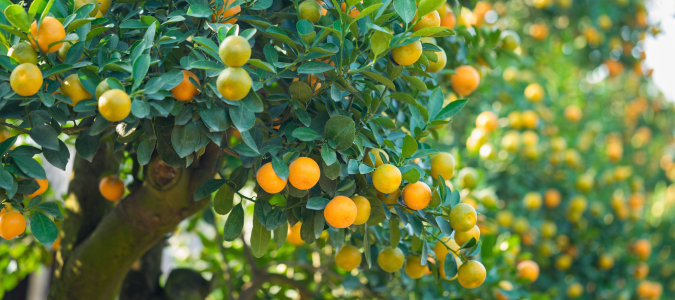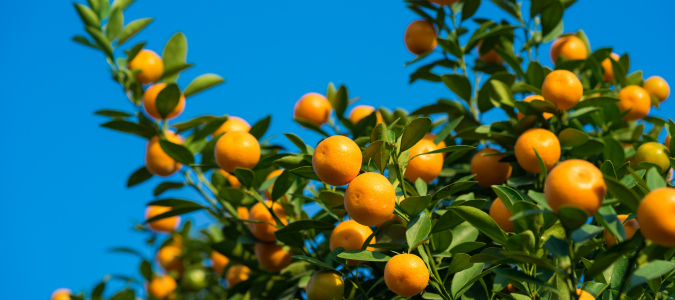Imagine waking up to a refreshing glass of freshly squeezed fruit juice every morning. With citrus trees in your garden, you can enjoy this. But to get the reward, you have to put some work into your citrus trees.
If you’re wondering how to prune citrus trees, here’s a guide to take you through the process. For busy homeowners who don’t have time for gardening work, a professional arborist can keep your citrus trees healthy and beautiful. The arborist has the tools and skills to prune, water and fertilize citrus trees.
How To Prune Citrus Trees: Methods, Timing and Equipment
Most deciduous trees need regular pruning to stay healthy. Pruning invigorates the trees and reconfigures their branches, making them less prone to breaking under heavy crops. It also helps them produce better-tasting fruits.
If you have experience with deciduous trees, like oak trees, you might think citrus trees require the same care. However, citrus trees are evergreen and are less fussy than their deciduous counterpart. Citrus wood is impressively strong and isn’t likely to break under hefty fruits.
The best part is citrus trees produce fruits that are just as tasty as more frequently pruned trees. But that’s not to say you can completely neglect your citrus trees. They still need pruning, both in the early stages and when they reach maturity. Young citrus trees need sprout removal and careful removal of fragile limbs. You must remove sprouts, deadwood and crisscrossed limbs as they age.
When to Prune Citrus Trees
There’s a specific time for pruning citrus trees using tools other than a simple hand pruner. Citrus trees in warmer areas need regular pruning in the spring, between February and April. But for citrus trees in colder areas, delay the pruning until the end of February or early March.
Pruning between the end of winter and the start of spring allows enough foliage to grow back in time for summer. If you expose large areas of wood during pruning, they will have enough shade under the canopy again once the intense summer sun rolls around. Most experts recommend not pruning your citrus trees between May and October because that leaves them with little sun protection.
The sun might damage exposed trunks and limbs, possibly causing sun scald. Your citrus trees could even get a Hendersonula bark rot infestation, a disease with no cure besides cutting limbs. It’s recommended to only prune them in the summer if you need to remove damaged parts of your citrus tree.
If you trim your citrus trees with a small hand pruner, you can do it at any time. Just be cautious not to over-prune them in the fall because that can lead to fragile regrowth that is susceptible to freeze damage in the winter.
Pruning Newly Planted Citrus Trees
If you are working with a newly planted citrus tree, you will see an explosion of new fruit in the first year the tree is in the ground. Although it may feel counterproductive, forgo pruning the crop and removing all fruit upon bloom. Removing the fruit helps the tree establish itself in the first year. Your first pruning on newly planted trees should occur in March after the tree has endured one winter season.
This first pruning will establish a good structure and shape for the tree as it matures. Most fruit tree experts will attest that having fewer branches will produce bigger and better fruit. Limit your tree to having a maximum of four to five primary branches that will be allowed to hold fruit. Most fruit is produced the second year, so be sure to remove and direct the branches not to be overcrowded thoughtfully. You can also contact a certified arborist to ensure proper pruning.
What to Prune and Materials You Will Need
Pruning your citrus trees with no strategy will do more harm than good. Citrus trees have thin barks that are easily damaged, so prune slowly and carefully. Here are the tools to prepare, which parts to prune and how to prune them.
Materials
While your bare hands might be enough for smaller citrus trees, you might need heavy-duty tools like the following for older and larger trees:
- Hand pruners or secateurs
- Loppers
- Pruning saw
- Pole pruner
- Chainsaw
- Orchard ladder
Sprouts
Sprouts, also called water sprouts, suckers or shoots, emerge from below or above the bud union or from large limbs. They can also shoot up from the soil around the trunk. You can spot them by their green and soft stems that lack bark. You should remove sprouts because they can out-compete the tree’s canopy and produce foul fruits.
The best way to remove sprouts is with your bare hands while they are still small. You can break them off easily without damaging the tree. For larger sprouts, use hand pruners to make clean cuts. Try not to let sprouts get so big that you need a saw to remove them.
Branches
Cut off small and large branches that are dead, crisscrossed or damaging the tree or fruits in any way. In addition, it’s beneficial to remove weak branches on small citrus trees to encourage larger ones to grow. You may also want to remove large branches that prevent light from seeping into the canopy. That can help improve the quality of the fruits. However, do this carefully because too much sun is harmful and can cause sun scald.
Hand pruners and loppers should be enough for smaller branches, but a sharp saw might be needed for larger ones. If this is the case, it’s best left to a professional.
Hedging
You can hedge your citrus trees to increase your property’s privacy. Plant them close together to create a dense and impenetrable barrier around your perimeter.
While homeowners may be able to prune their citrus trees, it’s often better to call in the professionals. Pruning is time and energy-consuming and requires investing in tools. Spare yourself from unnecessary stress by letting a professional arborist take over. The arborist will prune your citrus trees efficiently, ensuring they are in good condition.
How Often to Water Citrus Trees
Many homeowners wonder how much they need to water citrus trees for them to produce tasty fruit. Watering them too often or too little leads to the same thing–unhealthy trees.
If you have ground-planted citrus trees, ensure they get watered once a week, either manually or from rainfall. Soak the ground evenly and deeply to ensure they have water to last the entire week. Water your citrus trees slowly, letting the water seep two feet into the soil. Deep watering is especially crucial in the first three years of their life. They should never be dry for more than a day because they will lose leaves the next time you water them.
But just as deep watering is essential, it is also crucial to have proper water drainage. Otherwise, your citrus trees will drown, causing their leaves to go yellow and eventually fall off. As for citrus trees in containers, only water them when their soil is dry or slightly damp. Again, ensure there is excellent drainage to prevent overwatering.
Watering citrus trees can be tricky. If you lack experience, it’s better to let a professional arborist take over. They know how much water your citrus trees need and can create the ideal watering schedule for them.
How to Fertilize Citrus Trees
Fertilizing citrus trees is an essential part of their care and maintenance. While citrus trees don’t need fertilizer for the first one to two years of their lives, they require more nutrients as they mature. Depending on the type, citrus trees generally require fertilization three times a year.
That said, too much fertilizer can be a bad thing. Your citrus trees might produce fewer and less tasty fruits. It’s important to always observe how the trees are looking. If they have dense, dark-green foliage with fruits that don’t fall off easily, they are healthy and don’t need more fertilizer. The best time to fertilize them is in the spring and summer when they are about to bloom.
The main nutrient citrus trees need is nitrogen, and organic, all-around citrus fertilizers are a great source of that. Citrus trees also thrive in slightly acidic soil, so it can be beneficial to use an acidic fertilizer. Fertilizers made for succulents and cacti will work just as well for citrus trees. If you’re new to fertilizers, read the package instructions carefully and follow them to the letter.
But if you don’t want to stress about fertilizer, seek the help of a pro. A professional arborist can select the best fertilizer according to your citrus trees’ needs and apply it at the most optimum time.
Let a Pro Take Care of Your Citrus Trees
Even if you love your citrus trees, you might need more time, tools or know-how to keep them healthy. If their leaves are yellowing or falling off, you don’t have to worry because a professional arborist can come to the rescue. The arborist will assess your citrus trees’ needs and provide them with the best care. They can also prune other types of trees, like crape myrtles.
ABC Can Keep Your Citrus Trees Healthy
There can be a lot involved with taking care of trees. For healthy, happy trees, contact ABC Home & Commercial Services. Our certified arborists will ensure that your trees grow strong and beautiful. Our tree services include tree trimming, fertilization and tree air excavation. Our pros can also trim fruit trees.



